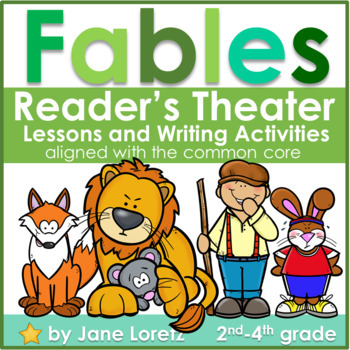Fables Reader's Theater, Lessons, Comprehension and Writing Activities
- PDF
What educators are saying
Also included in
- Fables The BUNDLE This unit is a bundle of both my fables units. You will have a total of 16 reader's theater scripts. Many lessons and writing activities that meet standards and the common core! This is discounted over 20% when purchasing the bundle.Learning fables and reading them in scripts arePrice $19.00Original Price $24.00Save $5.00
Description
Fables
This unit has everything you need to teach fables to your students. These Aesop fables come as reader’s theater scripts, this includes lessons, and comprehension worksheets that ask key ideas and questions and writing activities that meet many standards and important reading skills! I am super excited about this unit and I know you will be too!
This Fables packet is loaded with great activities to do with your students.
This packet includes 8 different Fables!
Children love to read with partners and their friends and rereading the parts to these scripts is great fluency and expression practice.
Included
The Lion and the Mouse-2 reader parts
The Ant and the Grasshopper-3 parts
The Tortoise and the Hare-6 parts
The Dog and His Bone-2 parts
The Fox and the Crow-3 parts
The Boy Who Cried Wolf-4 parts
The Rat and the Elephant-2 parts
The City Mouse and the Country Mouse-3 parts
Other activities included in this packet include:
Fable poster.
Lesson on character traits where students decide what traits are strengths and which are weaknesses or character flaws. This is a pocket chart activity where you help students sort the traits. (Word cards are included) Then students will take their knowledge of the traits and match them with the characters from the stories that they read. Two posters are also included.
Worksheets that ask key ideas and questions that align to the common core. Such as sequencing, comparing and contrasting, character traits, understanding elements of the story and understanding the moral or lesson.
Lesson in understanding the moral or lesson of the fable
Students match the fable to the correct moral or lesson and then to a real-life example. Use in a pocket chart or make an anchor chart.
Then check comprehension by having students do it independently with the worksheets included.
Students will test their knowledge of fables by writing their own. Students pick two characters and a moral. Planning sheets, final writing paper and the letters “Lessons Learned!” For your bulletin board are all included.
Please download the Preview for a great look at the unit.
Have fun and happy teaching! Jane
Related Products
If you enjoy using reader's theater in your classroom, please check out these fun and engaging resources.
• Fables 2 (Reader's Theater, Lessons and Writing Activities) Common Core aligned
• Fairy Tale Activities, story elements and elements of a fairy tale, writing
• Fairy Tales 2 reader's theater, activities, writing, plays, puppets
• Fairy Tales 3 reader's theater, writing, activities, plays, puppets
• Fairy Tales reader's theater, activities, writing, plays
• Presidents Day Reader's Theater ( Writing, Vocabulary, Activities )
• Tall Tales (Reader's Theater, Activities and Figurative Language Lessons)






